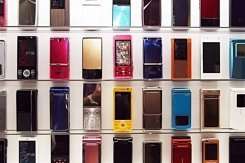September 10, 2009 weblog
Choosing a Low Radiation Cell Phone

(PhysOrg.com) -- An Environmental Working Group (EWG) team has released a consumer guide on the radiation levels emitted by over 1,000 cell phones sold in the U.S. The guide is the most comprehensive ever published, and is available online.
The guide is based on details of emission levels supplied by cell phone manufacturers, and enables consumers to make an informed decision about which phone to buy. The EWG believes a comprehensive guide of this nature was needed because U.S. laws do not require cell phone manufacturers to include radiation information on their printed materials and advertising, making comparisons extremely difficult.
Senior Scientist Olga Naidenko PhD, the leading author of the guide, said that while the research results are not yet conclusive there are concerns about the risk of cancer through exposure to radiation emitted by cell phones, PDAs and Smartphones, especially as recent studies have shown an increase in salivary gland and brain tumors in people using cell phones for 10 or more years. Research is continuing, and much more is needed, but it makes sense to reduce exposure in the meantime.
Cell phone radiation may be more dangerous for children than adults because their skulls are thinner and softer and less able to act as a shield protecting the brain from radiation. Studies have shown their brains absorb double the radiation absorbed by adult brains.
The wireless industry group CTIA disputes the need for the report, saying the scientific evidence indicates that cell phones and other wireless devices are not a public health risk. They also point out that organizations such as the World Health Organization, the U.S. Food and Drug Administration, and the American Cancer Society have all concluded that cell phones do not pose a risk to public health.
Governments in the UK, France, Germany, Finland, Switzerland and Israel disagree, since they have cautioned against excessive cell phone use, especially by children, and have recommended their use be restricted. In the U.S. cell phone standards are set by the Federal Communications Commission (FCC), but these standards are based on outdated (1992) recommendations that allow the levels of radiation entering the head to be 20 times greater than the trunk and limbs.
The EWG has urged the FCC to raise cell phone standards to accommodate the results of recent research, and the increasing numbers of children using the phones. As many as 71% of children aged 12 to 17 own cell phones, with more than 50% of them using their phone every day, according to the Pew Internet and American Life Project of 2008.
The EWG consumer guide tools are free (although they would appreciate a donation), and you can use the website to check out the radiation level of your own phone (even if it's an old model) or any phone you are considering buying. The search engine enables you to quickly compare every model made by a manufacturer or supplied by a provider, or compare every phone on the market.
The EWG guide lists the 10 lowest emitting phones and the 10 highest emitting phones. It also offers tips on reducing exposure to radiation from your phone, including using a landline in preference, texting instead of talking, and using headsets or speakerphones. They also advise avoiding using the phone when the signal is weak because radiation levels are raised when the phone tries to make a weak connection.
10 Best Phones
Listing is based on phones currently available from major carriers.
You can also see all available phones ranked by radiation.
1. Samsung Impression (SGH-a877) [AT&T]
2. Motorola RAZR V8 [CellularONE]
3. Samsung SGH-t229 [T-Mobile]
4. Samsung Rugby (SGH-a837) [AT&T]
5. Samsung Propel Pro (SGH-i627) [AT&T]
6. Samsung Gravity (SGH-t459) [CellularONE, T-Mobile]
7. T-Mobile Sidekick [T-Mobile]
8. LG Xenon (GR500) [AT&T]
9. Motorola Karma QA1 [AT&T]
10. Sanyo Katana II [Kajeet]
10 Phones That Emit the Most Radiation
1. Motorola MOTO VU204 [Verizon Wireless]
2. T-Mobile myTouch 3G [T-Mobile]
3. Kyocera Jax S1300 [Virgin Mobile]
4. Blackberry Curve 8330 [Sprint, U.S. Cellular, Verizon Wireless, MetroPCS]
5. Motorola W385 [U.S. Cellular, Verizon Wireless]
6. T-Mobile Shadow [T-Mobile]
7. Motorola C290 [Sprint, Kajeet]
8. Motorola i335 [Sprint]
9. Motorola MOTO VE240 [Cricket, MetroPCS]
10. Blackberry Bold 9000 [AT&T]
More information: www.ewg.org/cellphone-radiation
© 2009 PhysOrg.com
















